1043: Prince Vladimir Yaroslavovich goes to Constantinople
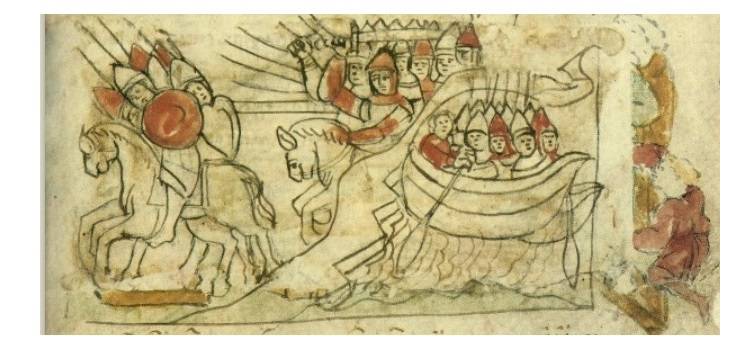
The battle of Prince Vladimir with the Byzantines in 1043. The Radzivilov Chronicle. XNUMXth century Miniature
We stopped at the last siege that took place in the X century, it was the campaign of the Grand Duke of Russia - Igor.
For Constantinople and for the Roman Empire, it is often customary to write that the 867th century is a time of brilliant victories. Of course, this period, formally the era of the reign of the Macedonian dynasty (1056–XNUMX), is the time of the Byzantine Renaissance, great victories in the East and North, and the accidental capture of Bulgaria. This is the peak of development, both the economy and the culture of the country, but also the age of marker defeats, where entire huge armies died during expeditions. For the time being, not much attention was paid to it.
But the forces of the state were undermined gradually: the struggle for the right to manage the resources of this great country caused much more significant damage to the state than all external invasions. The battles between those who sat in Constantinople and those who wanted to take the throne in the capital were in no way inferior in scale to battles with external enemies. It was this factor that was key in the development of Byzantium, which finally led to irreparable defeats from neighboring ethnic groups and countries.
And at the end of the Byzantine Renaissance, the Rus attacked Constantinople in 1043 again.
This event is reported by six Byzantine sources, three authors who were, to one degree or another, direct eyewitnesses of the events. Michael Psellos was in the retinue of the basileus, Michael Attalias was also in the capital at that time, John Skylitsa may have caught these events at a young age. Zonara wrote a hundred years later, and two more authors are simply compilers. Russian chronicles wrote about this event. Several eastern authors also reported on the Russian campaign.
Home
How did events develop? In Constantinople in the market there was a skirmish between the Rus and the Greeks, and one of the noble Rus was killed. Skylitsa wrote about this. But this, so to speak, became a reason, but was there a reason for the invasion?
Historians put forward different versions.
There is an assumption that Prince Yaroslav Vladimirovich had been planning this campaign for a long time and was looking for allies for him in Europe.
Another version: the Russians were called for help by the outstanding commander Georgy Maniak, who rebelled against the new emperor Constantine IX Monomakh, in whose army there were Russian mercenaries.
About the first reason, we can say that if Yaroslav was looking for allies, it was not very productive, since he never found them.
As for Maniac, his uprising happened suddenly, the commander himself counted on huge rewards from Constantine IX for his exploits, and he did not plan a rebellion. It happened suddenly. Therefore, he could not turn to the "archon dew" for help.
As for the occasion, perhaps it should be combined with the cause. There were quite a few Ruses, like the Varangians, in the army of the Byzantine Empire. As Kekavmen wrote about them: dews are spearmen, veringi are sailors. Constantly made trips to the capital of the Romans and Russian merchants. It was the Russian corps, sent to Vasily II from Vladimir Svyatoslavovich, that saved this emperor and his throne from usurpers.
Therefore, the murder of a noble Rus could well be not only a reason, but also a reason for a campaign.
Many researchers were surprised that Russia, having become a Christian state, should not have attacked its spiritual metropolis, although some just believed that this campaign provided the opportunity for the accession to the throne of the first Russian Patriarch Hilarion in 1050.
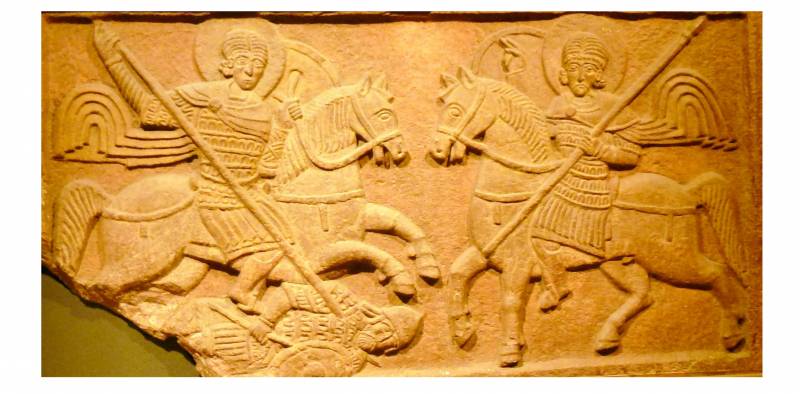
How the warriors of this particular period looked like can be seen in a magnificent image from the Kyiv church of St. Michael in 1060. Reenactors like to unite Byzantine weapons under one common period of the 1060th-XNUMXth centuries, with some common, unifying elements in each of these periods, this is still different equipment and weapons. Church of St. Michael. Kyiv. XNUMX State Tretyakov Gallery. Moscow
And, of course, Michael Psellos was not particularly puzzled by the reasons, but wrote in the framework of the written tradition that the dews, filled with hatred, were always ready to attack Byzantium. He believed that while the formidable Vasily II the Bolgar Slayer was in power, as we wrote above, who was saved by Prince Vladimir, and Constantine VIII, the Rus did not think about attacks. But power staggered under the basileus Roman III, and even more so under Michael IV. It was against the last king that the blow of the Russians was directed, which went to the new king - Constantine IX Monomakh.
You can understand Michael Psellos, he thought in medieval categories: if the incident with the murder of a noble Rus happened under Michael IV, what does Constantine IX have to do with it? However, in this he is similar to our contemporaries, who reduce development stories exclusively to the rule of individuals.
Trekking
Yaroslav entrusted the campaign to his 23-year-old son, who was in Novgorod, Vladimir.
Prince Vladimir, completely in the tradition of campaigns to the south, gathered an army, the composition of which we can only judge from indirect data. The army consisted of Novgorodians and Kiyans, or city militias:
He also gave him the Varangians, perhaps those who were in Kyiv. Yes, Vladimir
And of course, the prince had his squad.
The same author believed that the Rus were 100. According to modern researchers, based on the Russian chronicle, the army was 000 strong, which is also a huge and impressive figure.
A certain time has passed since the murder of a noble Rus.
All this army moved south, where, perhaps, what we do not know for sure, was reinforced by southern wars. It was in Kyiv in May 1043.
Having overcome the rapids, the Rus, as Konstantin Porphyrogenitus also described it, entered the Black Sea.
In Byzantine sources, we are talking exclusively about the leader of the Russians - Vladimir Yaroslavovich, Yaroslav Vladimirovich is not mentioned.
But back to Constantinople. Shortly before this, in 1042, Constantine IX Monomakh became emperor after a series of changes of basileus. So important for Russian history, whose symbolic “hat” became a royal symbol in Russia.
The blow of the Rus was not directed against the basileus personally, but against Byzantium. It was a punitive action, with the aim of restoring the rights of the Rus, which were violated, and no one was punished for this.
Traditionally on the Danube flotilla Rusov became for a day. Katakalon Kekavmen, the strategist of the Danubian theme, warned the capital. Several important events took place here.
First, an embassy arrived here from Constantine IX Monomakh, who tried to negotiate with Prince Vladimir. He was ready to reasonably compensate for all the losses suffered by the Russians in Constantinople, and confirmed by the charter all previous agreements between the two states. But the young and ardent Prince Vladimir did not agree with this. Apparently, this was also connected with the dispute that took place between the Rus and the Varangians. The Varangians wanted to go to Constantinople, Russia, most likely the Novgorod and Kiev militia, was ready to agree with the proposal:
Michael Attaliat reports that the naval war spread to Propontis, i.e., the Rus began to plunder the coast. It was they who were prevented by the strategos of the border theme Katakalon Kekavmen, not allowing them to land on the shore.
The emperor began preparations for the defense, he sent the Rus, possibly the Varangians, to various topics so that they would not be in the capital.
And then the opinions of the sources differ. We are talking about the fleet of the Romans. Someone writes, like Skylitsa, that there was no fleet, since in 1040 it burned down. Michael Psellos noted that there was a fleet, but it was scattered among various sea themes, including fire-bearing dromons.
Obviously, Monomakh did not assume that the threat was so global, and thought that the negotiations would solve everything. As the researchers note, here, as in the uprising of the commander Maniac, there was an element of surprise. No one expected that the negotiating actions would lead to fighting.
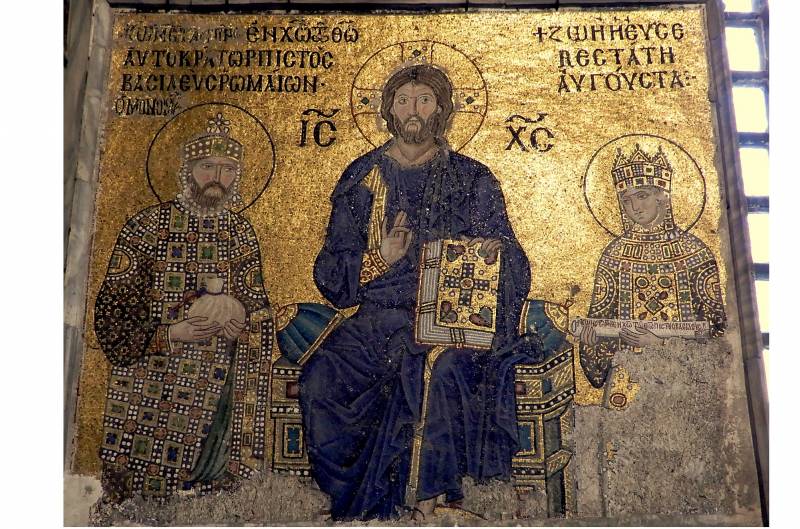
Constantine IX Monomakh. Portrait. St. Sophia. Istanbul. Author's photo
At the same time, Constantine IX began to gather troops to the capital, two tagmas (1 soldiers each) and two etherias (000 soldiers each) came to the city. The theme fleet of Constantine Cavallurius also approached. This was the general of the marine theme of the Cyvirreots. By the time the Russians arrived, the Romans were already fully armed.
The Rus made their way through the weak protection of the Romans and ended up in the Bosphorus Strait, where they camped on the shore. Michael Psellos believes that they entered there secretly, although it is difficult to imagine how such a force could pass secretly. Further events will unfold at Pharos. But there were two Faros: one at the entrance from the Sea of Marmara, the other - in Constantinople.
Where did the Russian fleet become?
Some historians believe that in the north of Propontis at the entrance to the Black Sea, where a battle took place at sea near Hieron (modern ruins of the fortress of Hieros) with Prince Igor.
Others - that the battle just happened at the entrance from the Sea of Marmara, where the Russian boats could pass, especially since the Bosphorus is not so big that even a rowing squadron could not pass it.
Logically, the Rus in this case could be located on the eastern shore of the Bosporus.
It is not entirely clear why the Russians needed to go past Constantinople, which remained on their starboard side, to the south, and even more so to camp on the eastern side.
Yet, most likely, they camped on the western, European part of the Bosphorus, north of Galata.
Two fleets lined up opposite each other: from the south-west side, covering the capital, the Romans, from the north-east - the Rus. Vasilevs Konstantin himself was on his imperial dromon. But the battle did not start, apparently, the Rus had not only small one-trees, as Attalus wrote:
Here again Emperor Constantine sent ambassadors to Prince Vladimir. Vladimir demanded payment, but different authors have different numbers. Michael Psellos even exclaims:
According to Psellos - 1 nomisms per ship, Skylitsa - 000 per detachment. G. G. Litavrin sees no contradictions here, considering that there are 216 people on the ship, and 50 soldiers in the detachment. Moreover, if the number of soldiers is 10 thousand, then the total amount is not so big for the Romans, that is, 20 thousand nomisms. He gives an example that during this period even private individuals had similar fortunes, so in 400 about 1042 thousand nomisms were confiscated from the nobilisimus Constantine. In 380, 1043 nomisms were confiscated from the property of the deceased Patriarch Alexei Studit.
Monomakh believed that the incident with the noble Russian was insignificant and not worth such compensation. Although he was ready to pay a certain amount, which the Russians looked at differently, especially since the mass of soldiers went on a campaign not just like that, but for prey. The negotiations ended in nothing, and the Russians offered to solve everything during the war.
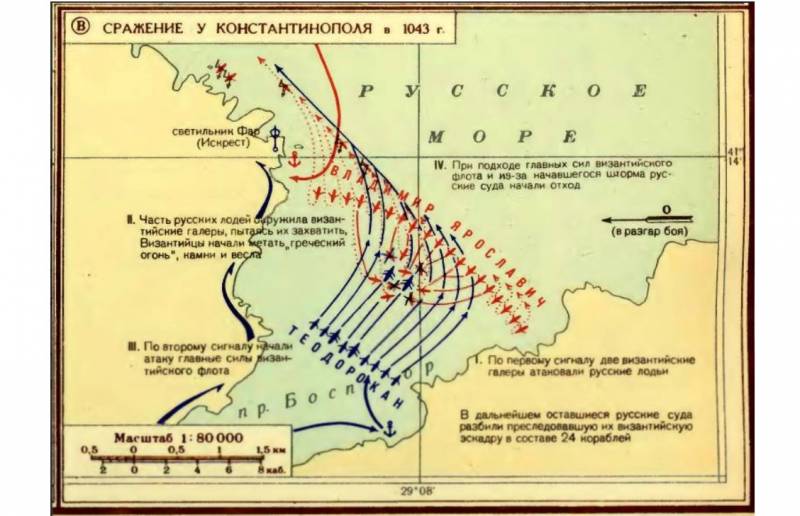
Modern battle map
battle day
The date of the battle is 10 or 17 July. Vasilevs again built the fleet in the morning, all the fire-bearing ships were put to sea, the fleet was reinforced with cargo ships.
The Russians, having left their camp, blocked the Propontis, building a fleet across the strait, at an angle, from west to east, facing towards Constantinople.
Considering that, as Michael Psellos wrote, the emperor observed and controlled the battle from the shore, it means that he was in the Grand Palace or on a hill near the Big Vdorets, where the northeast of the Bosphorus is clearly visible. If the battle took place at Pharos, standing on the Sea of Marmara, then he could observe it only from the side of Vukoleon. Michael Psellos wrote that
But such a hill is only from the side of the Grand Palace, and Vukoleon was on the very shore, and not on a hill.
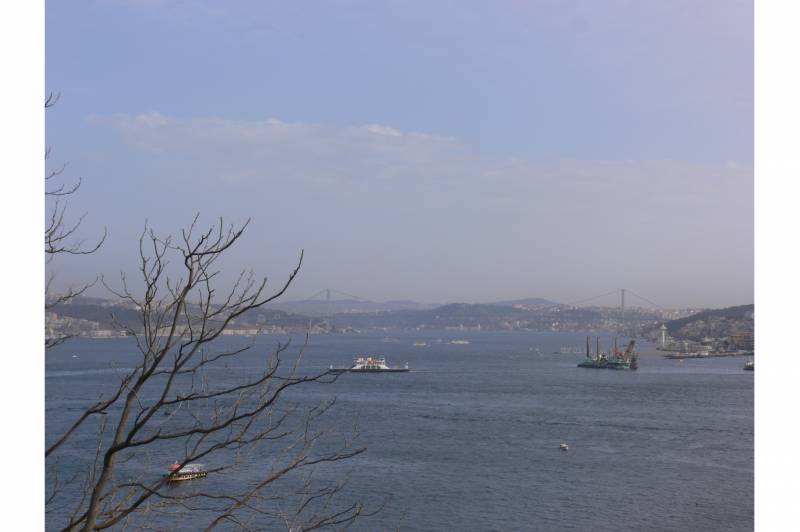
View of the Bosphorus from the former Grand Palace. Istanbul. Turkey. Author's photo
The fleets lined up again, but neither side started the battle. In the afternoon, Constantine ordered that Master Vasily Theodorokan act as a skirmisher, attacking the Rus: two or three triremes-dromons stepped forward. This prompted the Russians to start the fight too:
In the fabulous "Saga of Ingar the Traveler", which, however, has some historical basis, we find a description of "Greek fire", which gives some historians the right to write that the Swedes of Ingar participated in the campaign of Vladimir in 1043.
After that, the emperor moved the entire fleet against the Rus:
writes Attalus.
The formation of the Russians crumbled, some resisted, others fled. Basil Theodorokan landed on an enemy ship and captured him personally.
How events happened after that - opinions differ. Psellos writes that a storm arose from the east, that is, it hit the Russian fleet in the rear, some ships died, and some fled. The Russian chronicler writes about the same, even the ship of Prince Vladimir was wrecked, and Ivan Tvorimich, the governor of Yaroslav, took it on board. They were pursued by the Romans, attacking all over the Propontis:
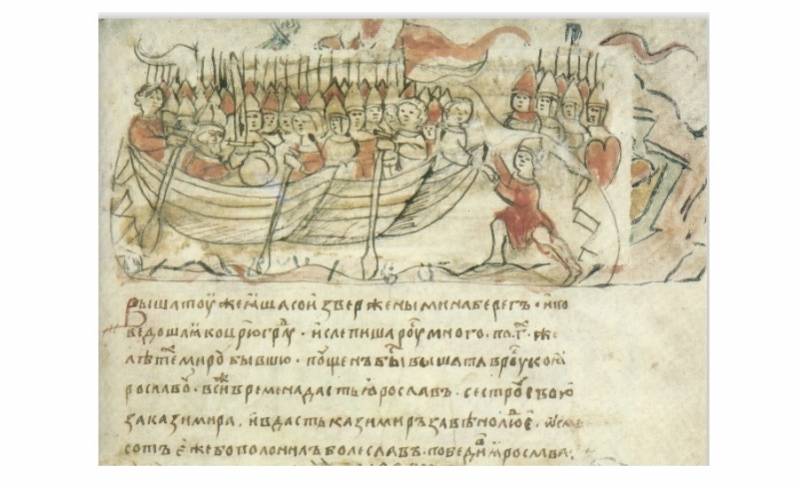
The battle of Prince Vladimir with the Byzantines in 1043. The Radzivilov Chronicle. XNUMXth century Miniature
Skylitsa writes about the incredible fifteen thousand killed Russ. Their corpses were robbed by Byzantine warriors, who enriched themselves significantly by removing many excellent and richly decorated equipment from the corpses. A significant part of the surviving troops made it to the shore of the European part of the Bosphorus. If the battle had taken place at the exit from the strait to the Sea of Marmara, the Rus could not have ended up in this part of the strait in any way, since there would have been an enemy squadron on their way, on the sea, and Constantinople on land, it was impossible to bypass it. Therefore, the battle could only take place in the northern part of the Bosphorus, in relation to the Byzantine capital.
The warriors, practically undressed, as many of them took everything off themselves when they hit the sea, gathered on the shore. There was a return journey for the defeated army. If we bluntly proceed from the fact that there were 50 soldiers on each single-deck boat, and only 400 out of 220 ships, according to researchers' estimates, then 17 thousand soldiers had to be transported. There were 20 thousand, 3 thousand died with 60 rooks, 6 escaped, but lost 000 rooks, and 120 thousand left 11 rooks. It is difficult to agree with such arithmetic.
Here it should be assumed that the losses were much greater, not without reason Skylitsa wrote about 15.
The quality of the ships and their sizes among the combatants, the Varangians and the militias were different. For example, we know the find of a flat-bottomed ship of the end of the 10th century from Novgorod, the Trinity excavation site, XNUMX meters long. Vasily Theodorokan cleared the deck of the Russian ship by force, and it was unlikely that it was just a big boat.
It can be assumed that, first of all, the small, less seaworthy and storm-adapted boats of the militia perished, what can we say if the ship of the prince himself also sank.
Thus, the most high-quality ships were saved, which, of course, were with the prince's warriors and the sailors of the Varangians.
Indirect evidence of this is the message in the annals that none of the squad did not want to go with the howls left without courts. They were headed by the governor Vyshata or Vysheslav.
Vyshata was closely associated with Novgorod, because both his father Ostromir and his grandfather Konstantin were posadniks in Novgorod, and his great-grandfather was Prince Vladimir's uncle Dobrynya himself. Therefore, the Novgorod Vyshata went on a campaign with the militia, first of all, probably, from the Novgorod land.
While a detachment of ships of the sea theme was sent in pursuit of the Russians.
24 dromons were sent in pursuit of the Rus, and in one of the bays, the name of which is not indicated, they attacked the Rus. The attack was launched by three ships that broke through the Russian system, and it already seemed that their fleet had been defeated, then the remaining dromons went on the attack. But the Russians attacked the Greeks, despite the personal courage of the commander of the theme, navarch Konstantin Kavallurius, they defeated the enemy.
The fate of the foot militia was different. On the way back, just before approaching the Danube border, the ground army, which was led by Vyshata, was defeated by the strategos of the border theme Katakalon Kekavmen. He captured 800 Rus and Vyshata himself.
It is difficult to understand why the combatants from the ships did not come to the rescue: either they were far from the place of the collision, or for some other reason. Prince Vladimir returned on ships to Kyiv, and the prisoners were brought to Constantinople, where they were either blinded, as the chronicler wrote, or their hand was cut off, as the Arab historians Ibn-al-Asir and Abul Fraraj, who lived much later, wrote.
This campaign did not weaken the position of Russia in any way, and three years later another treaty was signed. Researchers argue what prompted Constantine IX Monomakh to sign it. Although there are many reasons: the uprising of Tornik, which was assisted in the suppression by the Rus, and the threat from the Seljuks and Pechenegs, and the desire to protect themselves from Russia. That is why he sent his daughter Anna to Russia, to marry Vsevolod Yaroslavovich, father of Vladimir Monomakh.
Thus ended the siege.
To be continued ...
Information